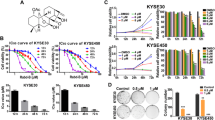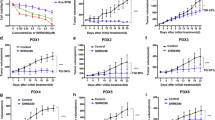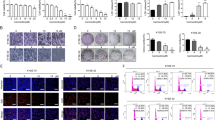Abstract
Purpose: Paclitaxel is a highly effective chemotherapy agent against adenocarcinomas and squamous cell carcinomas of the esophagus. However, its precise effects in human esophageal cancer cells are not well understood. This study was designed to examine the relationship between cell-cycle phases of paclitaxel-activated checkpoints and to elucidate the molecular pathway of the effect of paclitaxel in human esophageal squamous cell carcinoma (ESCC) cell lines. Methods: The three human ESCC cell lines—TE-2, TE-13 and TE-14—were examined for their response to paclitaxel. ESCC cells were treated with various concentrations of paclitaxel for 1–3 days using MTT assay. The cell-cycle progression and apoptosis were examined by flow cytometry. DNA fragmentation assay was carried out to confirm the fragmented cells as hallmark for apoptotic cells. In additional, the expression of apoptosis-related proteins in ESCC-treated cells was then examined by Western blot analysis. Results: TE-14 cells demonstrated the highest sensitivity among all cells. G2/M cell-cycle arrest occurs prior to paclitaxel-induced apoptosis in ESCC cells. The fragmentation of chromatin was observed in drug treated TE-13 and TE-14 cells by flow cytometry and DNA ladder formation. In contrast, the measurement for TE-2 cells was more suggestive of phenotype a resistant in response to paclitaxel treatment. Western blot analysis results showed that the mitochondrial pathway might be involved in paclitaxel-induced apoptosis in ESCC cell lines. Conclusion: Differential sensitivity was observed in human ESCC cell lines in response to paclitaxel treatment. G2/M arrest occurs with a prior to paclitaxel-induced apoptosis and might be mediated by the mitochondrial (intrinsic) apoptosis pathway in human ESCC cells.





Similar content being viewed by others
References
Collard JM, Otte JB, Fiasse R et al (2001) Skeletonizing en bloc esophagectomy for cancer. Ann Surg 234:25–32
Walsh TN, Noonan N, Hollywood D, Kelly A, Keeling N, Hennessy TP (1996) A comparison of multimodal therapy and surgery for esophageal adenocarcinoma. N Engl J Med 335:462–467
Urba SG, Orringer MB, Turrisi A, Iannettoni M, Forastiere A, Strawderman M (2001) Randomized trial of preoperative chemoradiation versus surgery alone in patients with locoregional esophageal carcinoma. J Clin Oncol 19:305–313
Wani MC, Taylor HL, Wall ME, Coggon P, McPhail AT (1971) Plant antitumor agents. VI. The isolation and structure of taxol, a novel antileukemic and antitumor agent from Taxus brevifolia. J Am Chem Soc 93:2325–2327
Schiff PB, Fant J, Horwitz SB (1979) Promotion of microtubule assembly in vitro by taxol. Nature 277:665–667
Schiff PB, Horwitz SB (1980) Taxol stabilizes microtubules in mouse fibroblast cells. Proc Natl Acad Sci USA 77:1561–1565
Donaldson KL, Goolsby GL, Wahl AF (1994) Cytotoxicity of the anticancer agents cisplatin and taxol during cell proliferation and the cell cycle. Int J Cancer 57:847–855
Legha SS, Ring S, Papadopoulos N, Raber M, Benjamin RS (1990) A phase II trial of taxol in metastatic melanoma. Cancer 65:2478–2481
Holmes FA, Frye D, Theriault RL, Walters RS, Forman AD, Newton LK et al (1991) Phase II study of Taxol in patients with metastatic breast cancer. Proc Am Soc Clin Oncol 10:60
Einzig AI, Wiernik PH, Sasloff J, Runowicz CD, Goldberg GL (1992) Phase II study and long-term follow-up of patients treated with taxol for advanced ovarian adenocarcinoma. J Clin Oncol 10:1748–1753
Stearns ME, Wang M (1992) Taxol blocks processes essential for prostate tumor cell (PC-3 ML) invasion and metastases. Cancer Res 52:3776–3781
Speicher LA, Barone L, Tew KD (1992) Combined antimicrotubule activity of estramustine and taxol in human prostatic carcinoma cell lines. Cancer Res 52:4433–4440
Tishler RB, Geard CR, Hall EJ, Schiff PB (1992) Taxol sensitizes human astrocytoma cells to radiation. Cancer Res 52:3495–3497
Ajani JA, Ilson DH, Daugherty K, Pazdur R, Lynch PM, Kelsen DP. (1994) Activity of taxol in patients with squamous cell carcinoma and adenocarcinoma of the esophagus. J Natl Cancer Inst 86:1086–1091
Nicholson DW (1999) Caspase structure, proteolytic substrates, and function during apoptotic cell death. Cell Death Differ 6:1028–1042
Green DR, Reed JC (1998) Mitochondria and apoptosis. Science 281:1309–1312
Li P, Nijhawan D, Budihardjo I et al (1997) Cytochrome c and dATP-dependent formation of Apaf-1/caspase-9 complex initiates an apoptotic protease cascade. Cell 91:479–489
Duan H, Orth K, Chinnaiyan AM et al (1996) ICE-LAP6, a novel member of the ICE/Ced-3 gene family, is activated by the cytotoxic T cell protease granzyme B. J Biol Chem 271:16720–16724
Casciola-Rosen L, Nicholson DW, Chong T et al (1996) Apopain/CPP32 cleaves proteins that are essential for cellular repair: a fundamental principle of apoptotic death. J Exp Med 183:1957–1964
Silke J, Ekert PG, Day CL et al (2001) Direct inhibition of caspase 3 is dispensable for the anti-apoptotic activity of XIAP. EMBO J 20:3114–3123
Silke J, Hawkins CJ, Ekert PG et al (2002) The anti-apoptotic activity of XIAP is retained upon mutation of both the caspase-3 and caspase-9 interacting sites. J Cell Biol 157:115–124
Samali A, Cai J, Zhivotovsky B, Jones DP, Orrenius S (1999) Presence of a pre-apoptotic complex of pro-caspase-3, Hsp60 and Hsp10 in the mitochondrial fraction of jurkat cells. EMBO J 18:2040–2048
Xanthoudakis S, Roy S, Rasper D et al (1999) Hsp60 accelerates the maturation of pro-caspase-3 by upstream activator proteases during apoptosis. EMBO J 18:2049–2056
Nishihira T, Hashimoto Y, Katayama M, Mori S, Kuroki T (1993) Molecular and cellular features of esophageal cancer cells. J Cancer Res Clin Oncol 119:441–449
McGuire WP, Blessing JA, Moore D et al (1996) Paclitaxel has moderate activity in squamous cervix cancer: a Gynecologic Oncology Group study. J Clin Oncol 14:792–795
Untch M, Untch A, Sevin BU et al (1994) Comparison of paclitaxel and docetaxel (Taxotere) in gynecologic and breast cancer cell lines with the ATP-cell viability assay. Anticancer Drugs 5:24–30
Nicoletti I, Migliorati G, Pagliacci MC, Grignani F, Riccardi C. (1991) A rapid and simple method for measuring thymocyte apoptosis by propidium iodide staining and flow cytometry. J Immunol Methods 139:271–279
Fan W, Schandl CA, Cheng L, Norris JS, Willingham MC (1996) Glucocorticoids modulate taxol cytotoxicity in human solid tumor cells. Cell Pharm 3:343–348
Liebmann JE, Hahn SM, Cook JA et al (1993) Glutathione depletion by L-buthionine sulfoximine antagonizes taxol cytotoxicity. Cancer Res 53:2066–2070
Chang YF, Li LL, Wu CW et al (1996) Paclitaxel-induced apoptosis in human gastric carcinoma cell lines. Cancer 77:14–18
Vaux DL, Korsmeyer SJ (1999) Cell death in development. Cell 96:245–254
Shibata Y, Haruki N, Kuwabara Y et al (2002) Chfr expression is downregulated by CpG island hypermethylation in esophageal cancer. Carcinogenesis 23:1695–1699
Susin SA, Zamzami N, Kroemer G (1998) Mitochondria as regulators of apoptosis: doubt no more. Biochim Biophys Acta 1366:151–165
Kroemer G, Reed JC (2000) Mitochondrial control of cell death. Nat Med 6:513–519
Saleh A, Srinivasula SM, Balkir L, Robbins PD, Alnemri ES (2000) Negative regulation of the Apaf-1 apoptosome by Hsp70. Nat Cell Biol 2:476–483
Jiang J, Ballinger CA, Wu Y et al (2001) CHIP is a U-box-dependent E3 ubiquitin ligase: identification of Hsc70 as a target for ubiquitylation. J Biol Chem 276:42938–42944
Nomura T, Mimata H, Takeuchi Y et al (2003) The X-linked inhibitor of apoptosis protein inhibits taxol-induced apoptosis in LNCap cells. Urol Res 31:37–44
Deveraux QL, Takahashi R, Salvesen GS, Reed JC (1997) X-linked IAP is a direct inhibitor of cell-death proteases. Nature 388:300–304
Faried A, Sohda M, Nakajima T et al (2004) Expression of heat-shock protein Hsp60 correlated with the apoptotic index and patient prognosis in human esophageal squamous cell carcinoma. Eur J Cancer 40:2804–2811
Acknowledgements
We Thank to Dr. T. Nishihira (Tohoku University School of Medicine, Japan) for providing the TE cell lines. Dr. H. Coley (University of Surrey, UK) for valuable discussion. This work has supported by Grants-in-Aid from the Ministry of Education, Culture, Sports, Science and Technology, Japan for A.F. and Grants-in-Aid for Scientific Research (C) 15591730 from the Ministry of Education, Science, Sports and Culture of Japan for L.S.F.
Author information
Authors and Affiliations
Corresponding author
Additional information
A. Faried and L.S. Faried contributed equally to this project and are considered co-first authors.
Rights and permissions
About this article
Cite this article
Faried, A., Faried, L.S., Kimura, H. et al. Differential sensitivity of paclitaxel-induced apoptosis in human esophageal squamous cell carcinoma cell lines. Cancer Chemother Pharmacol 57, 301–308 (2006). https://doi.org/10.1007/s00280-005-0038-z
Received:
Accepted:
Published:
Issue Date:
DOI: https://doi.org/10.1007/s00280-005-0038-z




